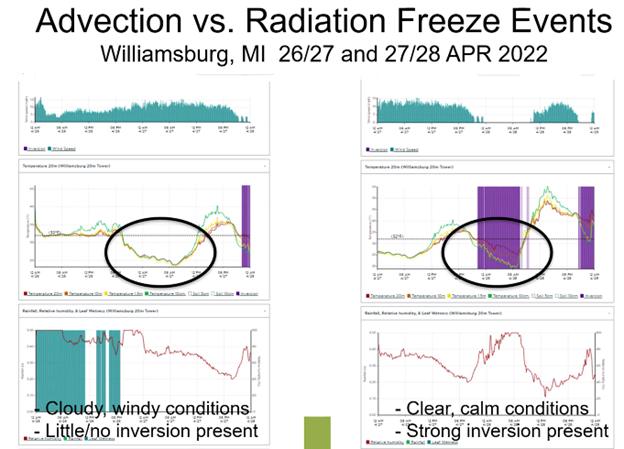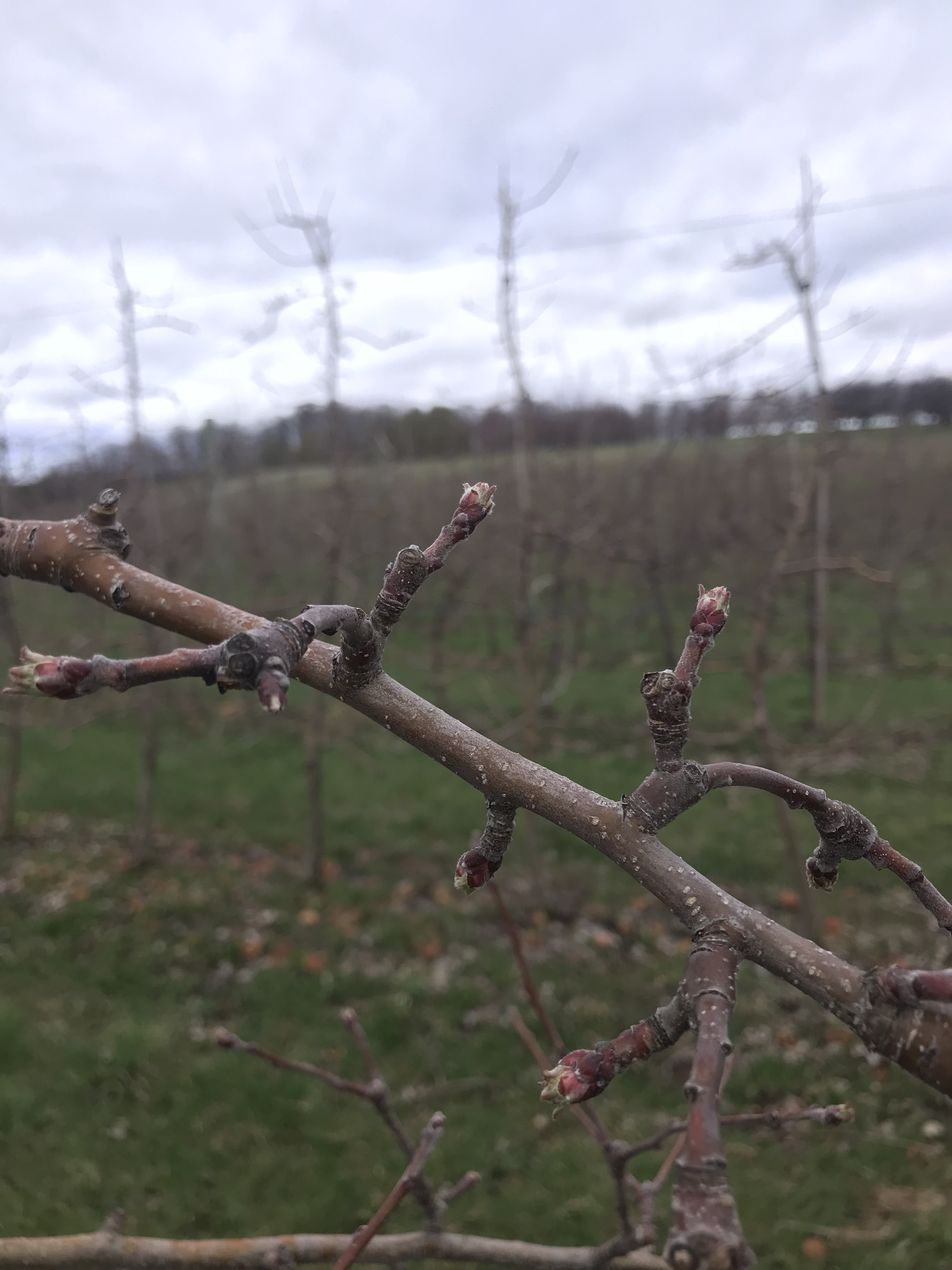Northwest Michigan fruit update – May 3, 2022
Cold weather persists in northwest Michigan, and there has been little movement in crop development in over a week.

Weather report
The weather continues to be cooler than normal over the past week, and the forecast is predicting this trend to continue until early next week. Temperatures have been 4, 5 to almost 10 F colder than normal for April. The northern part of Michigan has been even colder than normal compared to the southern part of the state. We are behind for growing degree day (GDD) accumulations for 2022. We have accumulated 133 GDD base 42 and 43GDD base 50. Although this spring has been seemed particularly cold, we had less GDD accumulations at this time in 2020. On May 2, 2020, we had accumulated 120 GDD base 42 and 28 GDD base 50. This year is also similar to the spring we had in 2014.
Last week was drier compared to the wet conditions we have observed during most of April. At the Northwest Michigan Horticulture Research Center, we recorded 3.26 inches of rainfall in April compared to 2.87 inches for our 23-year average, so 2022 has been slightly wetter than our past average rainfall totals. March 2022, however, was much wetter than our average whereas we recorded 5.33 inches of rain in 2022 compared to only 1.6 inch for our 23-year average. Soil moisture levels are at or above normal (80% higher than normal) at this time.
The weather is predicted to change tremendously next week, and mean temperatures are expected to be significantly above normal. The daytime highs will make it feel more like summer than May, and it will mark a complete departure in weather conditions from the past few months. Forecasts are predicting daytime high temperatures to be in the 70s and maybe even hitting 80s on a few days, which will be much warmer than normal temperatures for this time of year. The warmup is predicted to last about a week, then we will return to more normal temperatures. However, until next week, this Wednesday and Thursday (May 4 and 5) will remain fairly cool and dry. The weekend will be dry with some more moderating temperatures. For the northern part of state, forecasts are predicted to be dry for next week, but the southern part of the state could receive significant rainfall this week (and even up to one 1 today, May 3). There are no frost or freeze events in the forecast for the upcoming two weeks.
We did record cold temperatures on Tuesday and Wednesday nights last week (April 26 and 27). Temperatures varied across the region and some areas were significantly colder than others. Figure 1 shows the meteograms from the Williamsburg tower last week. Both nights and following mornings recorded freezing temperatures during that time (Tuesday and Wednesday, April 26 and 27), but the figures on the left show that Tuesday was cloudy and windy; therefore, there was no inversion predicted or recorded during that time frame. However, on April 27, the clouds cleared out and the wind calmed, as we approached the evening, a strong inversion formed. The graph on the right shows that there was a strong inversion where there was a difference of almost 10 F between the sensor around ground level and the sensor at 66 feet up on the tower. The 66 feet sensor still shows below freezing conditions, but the overall temperatures were still significantly warmer than the lower sensor. So, both evenings recorded freeze events, but one event was advective while the other was a radiation freeze.

Crop report
Crop development has moved little over the past week. We are still at green tip in Honeycrisp, but we moved slightly in Gala from 0.25-inch green to 0.5-inch green. We are still at side green in Montmorency and just a bit more advanced in Balaton where we observed bud burst this week. All varieties of sweet cherry did not move at all from green tip or side green that we observed last week. This predicted warm weather will move things along very quickly, and growers should be ready for development to advance. Growers should be sure to have sprayers up and working and calibrated in anticipation of the warm weather.

We have cut buds here at the research station following the two cold nights last week. We did not expect to see much damage given the overnight temperatures recorded on the Northwest Michigan Horticulture Research Center Enviroweather station; we recorded the lowest temperatures on Tuesday night into Wednesday morning of 23.5 F and 28.2 F on Wednesday night into Thursday morning. Both of those temperatures were not cold enough to indicate significant damage based on the old critical temperature charts. The old chart indicates about 10% damage at 24 F (Table 1).
| Table 1. Old critical temperature chart information indicating tart cherry bud mortality at different crop development stages. | ||||||||
| Tart cherries | Bud swell | Side green | Green tip | Tight cluster | Open cluster | First white | First bloom | Full bloom |
| 10% kill | 15 | 24 | 26 | 26 | 28 | 28 | 28 | 28 |
| 90% kill | 0 | 10 | 22 | 24 | 24 | 24 | 24 | 24 |
After cutting open buds at the station from different ages of Montmorency trees, we recorded observed more damage than we initially anticipated. This number was higher than we anticipated given the overnight lows recorded at the station. However, with the current forecast, there are no future frost/freeze events predicted, so we can still end up with a nice crop of tarts at the station.
We have also been collecting apple buds to further examine the impacts of cold temperatures on the different stages of Gala and Honeycrisp development. We are finding that the king buds of Honeycrisp are potentially more sensitive to colder temperatures than the old charts indicate. We are continuing to collect data this year and will have more information for the future. However, initial information does indicate that about 50% of king buds have been damaged here at the station. But as Honeycrisp is a large fruited variety, the lateral buds produce fruit that is more of an optimal size for markets. Lateral bud mortality in both Gala and Honeycrisp is low.
Insect report
Green fruitworm. With the continued cool weather, we have little to report for insect activity. We caught green fruit worm moths in traps this week and last week, and we have fewer than five moths per trap this week compared to numbers in the teens last week. However, with the warm weather expected next week, insect activity will certainly pick up.
San Jose scale. Some growers have been battling San Jose scale infestations in sweet cherry for many years. We have been recommending a dormant oil spray to smother the overwintering scale insects on the trees, and now would be an excellent time for the application of a dormant oil in sweet cherry. We are no longer able to use Lorsban in the tank mix for control of San Jose scale as this product use has been discontinued as of February 2022. Lorsban is not allowed for use of San Jose scale control any longer. Therefore, growers that have had San Jose scale in the past should be sure to apply oil this season to get a jump on controlling this difficult pest. There are no frost or freeze events in the forecast, and growers should make their oil applications as soon as possible if the warm weather causes sweet cherries to develop quickly (too much green tissue) beyond the time frame where oil is still safe to use.
Disease report
Bacterial canker. Bacterial canker is a concern with this cold wet weather, and we are still waiting for a stretch of dry weather to prune sweet cherries at the station. However, we have conducted past research to determine the impacts of cold and wet weather on sweet cherry pruning cuts with very little concrete information to provide growers. We were never able to show that pruning during cold and wet weather increased the incident of bacterial canker. In the years where we have seen the largest outbreaks of canker, they have been when we have had cold and wet weather during bloom. The weather is predicted to warm next week, and we anticipate all trees, including sweet cherry, to move quickly and some bloom could open if the temperatures reach as warm as they are predicting; therefore, bacterial canker infection potential should be minimal under warm conditions.
American brown rot. Although canker may not be a concern around sweet cherry bloom under these warm conditions, blossom blight control for American brown rot will be important. With warm weather, there can be infection during bloom resulting in blossom blight symptoms. The potential for blossom infection in Michigan is typically held in check by cooler weather as the optimal temperature for infection is between 72 and 77 F, and spore production is greatest between 59 and 74 F. However, growers should remember that favorable conditions for American brown rot blossom infection include relatively warmer temperatures with some rain—warmer weather is in our forecast, but the northern part of the state is expected to be dry for the coming week.
The best fungicide for American brown rot management during bloom is the dicarboximide fungicide Rovral. This is an effective American brown rot material during bloom because inoculum levels are lower and can be controlled. Also, since this fungicide has a different mode of action, it is an excellent alternate tool for fungicide resistance prevention. A maximum of two applications of Rovral can be used, and do not use this fungicide after petal fall.
Apple scab. Although apples in the region are still fairly tight, we are starting to see more green push, and we certainly will see green tissue with forecasted warm up next week. Growers will need to be ready to make apple scab applications to cover new tissue. The region is expected to be dry next week, but growers will need to be prepared for scab applications as spores will mature under warm conditions. Although the southern parts of the state have had more recent rainfall, Michigan State University Extension fruit educator Amy Irish-Brown caught a significant amount of scab spores over a wet weekend (200-plus per rod) compared to far fewer spores in prior weeks. This information is a heads’ up for our growers to be ready to start scab programs with the pending warm weather. EBDC’s are good products to be used early in the season as they have long PHIs.



 Print
Print Email
Email
